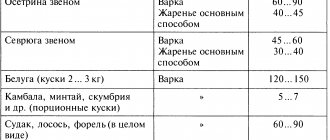Home/Expiration date/Sausages
Sausage is one of the most popular food products. The main ingredient in its production is minced meat in a shell. Since it is perishable, its total shelf life is short. But this is not an obstacle for many people to buy this delicacy. To minimize the risk of loss, you need to find out what the actual shelf life of sausage is. This material will be covered in the article.
Normative base
The legal norm regulating the shelf life of sausage is referred to as GOST. It contains individual standards for each type and type of sausage. This is a national standard of the Russian Federation, which includes the main criteria and requirements for sausage products, in particular for their storage. The standard contains a classification by category. Based on this, such products can be classified as groups A and B.
Attention! If you have any questions, you can chat for free with a lawyer at the bottom of the screen or call Moscow; Saint Petersburg; Free call for all of Russia.
- Category A. This is a product containing a mass fraction of muscle tissue of 60%. Water that was lost during heat treatment is not taken into account.
- Category B. This is a product that contains 40-60% muscle tissue, excluding liquid lost during heat treatment. This indicator is determined by calculation method.
Note:
Usually the shelf life of sausage is indicated by the manufacturer. Classic requirements require a temperature range of 0-6 degrees and a relative humidity of up to 75%.
The standard states that the shelf life of sausage depends on several factors:
- compound;
- quality and material of packaging (shell);
- type of product;
- variety;
- storage method.
Shell type
An unopened stick is stored under proper conditions based on certain criteria, one of which is the type of casing. The product is coated with it to create shape and protect it from the influence of the external environment. In the assortment of meat products you will find sausage in a variety of casings. Always pay attention to their integrity and absence of deformation.
Natural
Natural shells can be eaten and this is perhaps the only advantage. Otherwise similar shells:
- require more labor and time to manufacture;
- poorly cleaned;
- reduce shelf life to several days.
Nowadays, products in natural casings are found less and less often, since it is not profitable for either the manufacturer or the consumer for the sausage to be stored for only a few days.
Semi-synthetic materials
Semi-synthetic casings do not allow air or other external factors to enter the product. The shelf life of sausage in such a casing, subject to storage standards, will be approximately 14 days.
Vacuum packed
Improved packaging technology allows the product to be stored for a long period of 2 to 4 weeks.
Polyamide coating
A similar casing is used to preserve cooked sausages.
How to determine expiration date?
To determine the fact that the shelf life of the sausage is coming to an end, just look at the labeling: it will indicate the date when the product was produced and the time from which it becomes unusable. If for some reason this indicator is missing, or the packaging was lost or thrown away, you can determine the expiring shelf life of the sausage product using organoleptic methods:
- appearance : over time, the color of the sausage changes (especially along the cut edge) and can become whitish, greenish, sometimes spots appear on the surface, a slight coating, drying out;
- smell : food with expiring storage time has a characteristic “aroma”, it is noticeably different from that which appears in a fresh product, for example, it becomes more pronounced and pungent, sharp, and may have a sourish or sweetish, salty “tint”;
- tactile sensation : if you touch food that is nearing its expiration date, it will seem less elastic and may become covered with a slight slippery or sticky coating;
- taste : throughout the entire period of eating, the taste characteristics of the sausage are subject to change.
Additional information
These phenomena apply to absolutely all types and varieties. But sometimes the signs may not be noticeable. Therefore, it is recommended that when purchasing sausage, you immediately pay attention to the packaging, which indicates the period of suitability for consumption and the production date.
Shelf life depending on the type of casing
This factor has a direct impact on the period of possible suitability for use. Natural and artificial materials are used as raw materials for the manufacture of shells. In the first case, the intestines of animals are used, in particular sheep, pigs, and cows. In the second situation, plastics, viscose, cellulose, and fabric elements are taken as raw materials. It is synthetic products that are most often used in the manufacture of sausage packaging materials. This is due to the fact that they give the finished product a longer shelf life compared to natural casings.
Additional Information
Among artificial sausage coatings, polyamide material is often used. This is due to the fact that it is extremely durable and reliable, has a large number of antibacterial qualities and prevents the penetration of microbes and bacteria into food. A coating of this type is resistant to UV rays, protecting the sausage from premature spoilage, the appearance of excess moisture, and foreign odors. In such packaging, food can retain its consumer properties unchanged for several days.
Products that are cut and packaged in supermarkets can be stored for a week if there is a refrigerator. Currently, sausages are increasingly appearing that are packaged using new technology. Packages can be filled with carbon dioxide and other substances that prevent the penetration and development of bacteria and microbial elements. As a result, the shelf life of the finished sausage product is significantly extended.
Natural casings
They are used less and less due to ensuring only a short shelf life of the sausage. Producing food products in such packaging is unprofitable for the manufacturer and the retail chain, because they begin to deteriorate just a few days after release, even if they are not unpacked.
Semi-synthetic materials
This type of sausage coating is impermeable, so it can easily be used in the production of various types of products. Unlike natural casings, the shelf life is about 2 weeks, subject to compliance with the general requirements established by GOST.
Vacuum shell
This progressive type of coating ensures longer shelf life of the product. But after opening, it is recommended to use the sausage as quickly as possible in order to prevent losses from spoilage. The average period of suitability for consumption in such a shell ranges from two weeks to a month, sometimes more.
Polyamide coating
It is used for packaging boiled and boiled-smoked sausage and contributes to its maximum preservation.
It is important to choose the type of coating wisely if you want the product to retain its presentation and consumer qualities for the longest possible time. It is worth remembering that the packaging must be completely clean and dry, which will significantly extend the shelf life of the sausage.
Storing homemade sausages
Homemade products have a very short shelf life. This occurs due to the impossibility of creating the necessary sterility conditions, which can only be organized in production. In addition, when manufacturing on your own, a vacuum sealer is not always used. This also affects the shelf life of homemade sausage.
It is advisable to consume homemade dumplings within 48 hours. Cooked - smoked products will be suitable for consumption for 5 - 10 days.
If home-made sausage products need to be preserved for 2–3 months, they are placed in glass containers (ceramic containers can be used) and filled with melted lard. Various spices are first added to the lard if desired. You need to store homemade sausage in pork fat in the refrigerator or cellar.
There are other options for storing homemade sausage. The simplest and most optimal of them is storage in the freezer as a semi-finished product. If necessary, the products are defrosted and brought to a state of readiness.
Average shelf life of boiled sausage (factory-made and homemade):
- in the refrigerator – 3 – 5 days;
- in the freezer for about 2-3 months.
Shelf life of boiled sausage
In the Russian Federation, the production and storage standards of this type of product are regulated by the GOST 52196-2011 standard. Boiled sausages are made from carefully salted minced meat. Then they are cooked at a temperature of about 80 degrees Celsius. Based on the specific formulation, such products may fully or partially include soy, a meat substitute, and other similar ingredients. Boiled sausages contain the maximum amount of water, which explains their shortest shelf life. According to GOST, these products must be sold within a certain time:
- meat loaf, boiled products - 72 hours before;
- liver, blood, as well as sausages and sausages belonging to the 1st and 2nd grade - within 48 hours;
- jelly, blood and liver products - up to 12 hours.
As for storage time, they depend on its variety, type of shell, and conditions.
| Product name | Doctoral | Dairy | Livernaya | Sausages |
| In a refrigerator - if the “stick” has not been started; - if it is started (opened) | 2-4 weeks 1 Week | 1 Week 4-5 days | 2-3 weeks 6-10 days | 1 Week 4-5 days |
| In the freezer | Boiled sausage is a product that is not suitable for keeping in the freezer, because after defrosting there is a risk of getting a tasteless product with an unusable consistency, which is caused by the high water content. If you decide to store in the freezer, it is best to choose a vacuum-packed product. The average shelf life is 5-6 months. | |||
| At room temperature | 4-5 hours | 2-3 hours | 5 o'clock | 3-4 hours |
How long can sausage be stored without refrigeration?
It is not always possible to store sausage in the refrigerator. There are a lot of reasons. This includes a trip to nature, large supplies, and anal breakdown of the unit.
What to do in such a situation?
Remember, raw smoked sausage can be stored for quite a long time without refrigeration. If you provide it with a dark, cool, well-ventilated place, and not even put it there, but hang it up, then you can be 100% sure of freshness for 10 days, and if it’s not summer, but a cooler time of year, then immediately multiply this period by two .
The same applies to dried and all types of smoked sausage. But boiled, blood and liver will not withstand such storage. It is better to eat them immediately. Sealed packaging will help to slightly increase the shelf life.
Shelf life of boiled sausage in the refrigerator
If we take into account cold storage, then on average its duration ranges from 3 to 30 days, depending on whether the “stick” has been started or packaged, the type of product, the material and the quality of the packaging. If the coating is vacuum, and the sausage is doctor-grade and not yet started, it can lie for almost 1 month without losing its consumer qualities. If we are talking about a dairy variety that has already been started, then the duration of suitability can be reduced to several days (4-5).
How to keep boiled sausage fresh and can it be frozen?
The maximum shelf life of cooked sausage is 75 days, provided that it is in a polyamide barrier casing without the use of a vacuum or modified atmosphere. However, most often they buy a product that is more affordable. And few people pay attention to the type of shell.
At the same time, much in the shelf life of sausage depends on its packaging:
- Natural casing. Organic fillers (animal intestines) are used. The advantage is that the composition is completely natural; the product can be eaten together with the casing. However, this is also a minus - microorganisms easily multiply on the casing, which then transfer to the sausage.
- Polymer shell. Such packaging is considered more preferable, as it is easy to clean and tightly covers the product, eliminating the appearance of air, which contributes to the proliferation of microorganisms. The polymers used for packaging are harmless to the body, but they cannot be consumed as food - the product is cleaned of its shell.
The maximum storage period is indicated by the manufacturer, but on average does not exceed 30 days. You should not buy sausage that is about to expire. Despite the fact that the meat is heat-treated, it can lead to serious disorders of the gastrointestinal tract.
The shelf life of an open stick of sausage is even shorter - it ranges from 3 to 14 days. The optimal temperature is from +2 to +4°C. If there is a lot of sausage, you can freeze it.
Reference. Only high-quality products that contain a significant percentage of natural ingredients can be frozen. The higher the price, the more natural meat the product contains.
How to store boiled sausage and other sausage products in the freezer
In a standard freezer the temperature is -18°C. This is the optimal temperature to keep food fresh. You should not freeze sausage that is past its expiration date - pathogenic microorganisms begin to multiply in such a product. And even such a low temperature will not stop this process. It is better to fry such sausage or prepare it in another way and eat it immediately.
In the freezer you can put either a whole stick, not yet opened, or cut into small pieces or slices. Freezing rules for different types of sausage:
- For the whole . Wrap it in cling film or a plastic bag several times, being careful not to leave any air inside. Then tie it tightly. After that, put it in storage.
- For chopped. First, the circles can be fried on both sides in a frying pan with a small amount of oil. Place pieces of parchment paper of a suitable size between them - this way they will not touch each other and contribute to the development of microorganisms. If there is no contact, they will freeze faster. Then wrap tightly in a plastic bag and place in the freezer.
A whole stick of sausage preserved in this way can be safely eaten for sandwiches - the taste and quality will remain unchanged. But with pieces the situation is different. Most often, a product that is to be further hot processed - making pizza, solyanka or frying - is frozen in this way. Thermal exposure is guaranteed to destroy possible microbes.
After defrosting, the whole stick retains all its properties, but it may be a little watery. There's nothing wrong with this - just dry the sausage with a kitchen towel.
Important. Boiled sausage can be stored in the freezer for no more than 2 months.
Sausages, sausages, smoked brisket, and ham are stored in the same way. The presence of fillers does not play any role. The situation is easiest with sausages. To do this, it is important to remove the threads connecting them and separate them from each other. It is not necessary to defrost them before cooking - immediately put them in cold water and put them on fire. The cooking process will increase by 3-5 minutes, the taste will remain unchanged. Do not put frozen sausages directly into hot water. This will cause their shell to crack and they will cook unevenly.
You can freeze smoked and raw smoked sausage in the freezer. Such sausages are preserved much better than boiled ones - thanks to the smoking procedure, excess moisture is removed. Smoke treatment is an excellent way to preserve food. Smoked sausages can be stored in the refrigerator for up to 9 months.
The use of sodium salts in production also helps to increase shelf life. Therefore, when defrosted, all products retain their taste. They are used not only for preparing other dishes, but also consumed cold.
Attention. Sausage should not be defrosted at room temperature by placing it near a radiator or in the sun. If we are talking about a whole stick that is planned to be used for sandwiches, it is placed in the refrigerator to defrost. At low above-zero temperatures, it will thaw in about 8-12 hours, depending on the thickness. In other cases, frozen pieces are immediately sent to the dish for which they were intended.
The nuances of preserving homemade boiled sausage
Homemade boiled sausage is made according to a special recipe. It most often contains meat, lard or lard, spices and herbs. The casing is made from cleaned intestines. The method of storing such sausage depends on the degree of its readiness. The sausage is considered ready when it is baked in the oven. After this, it is stored in the refrigerator at a temperature of +2 to +4°C.
The use of a natural shell leads to the fact that the shelf life of the finished product in the refrigerator is limited to 3-7 days. It spoils much faster, so the standard 30-day shelf life is not suitable for it.
Homemade sausage is also stored in the freezer. It can be placed there before it is cooked in the oven. It will turn out even better this way - until it is completely cooked, it is stored as a semi-finished product, after which it is baked in the oven and eaten.
The finished product can also be frozen, but no later than 3 days after preparation. The shelf life in the freezer should not exceed 14 days, and after defrosting it is better to fry it or warm it thoroughly in the microwave.
Important. If you re-freeze the sausage, it will spoil. Its taste and appearance will change - this product should not be consumed.
Shelf life of raw smoked sausage
Features of storage of raw smoked products in the Russian Federation are regulated by GOST R 55456-2013. According to this standard, raw smoked sausage should be stored at a temperature of 5-8 degrees (that is, in the refrigerator). The shelf life of a sealed “stick” can last 3 months, but after opening it is necessary to use the product within 2-3 weeks. If an opened stick of sausage is placed in the freezer, it will remain there for 1-2 months, remaining usable.
For your information
If you store it in the freezer unpacked, the duration will “stretch” up to 9 months. To avoid premature damage, you should also pay attention to products in high-quality and reliable packaging.
How to store at home?
Different sausages require different conditions when stored at home:
- In the room, in the air. It is important to keep in mind that boiled and liverwurst, and sausage products made from them, should not be left indoors at room temperature for a long time. After just a few hours they become dangerous to eat. Sausages of various types of smoking can be stored for several days in the fresh air if additionally wrapped in baking paper.
- Fridge. It ensures safety throughout the standard shelf life. It is important to ensure the following temperature conditions:
- boiled sausage – 2-4 degrees;
- homemade and liverwort - no higher than 5 degrees;
- dry-cured - up to 6-7 degrees;
- boiled-smoked and semi-smoked products - no higher than 10 degrees;
- raw smoked varieties – 6-14 degrees.
Is it possible in the freezer?
Low temperatures can significantly increase the shelf life of sausages, but only if their moisture content is low. Thus, products smoked in various ways, dry-cured products and most home-made sausages tolerate freezer conditions very well. They can be stored for several months and sometimes up to 1 year.
It is important to check the integrity of the shell before placing it in the chamber , and if it is broken, wrap it in paper. It is not recommended to place boiled sausage, frankfurters and sausages in the freezer.
Homemade product
Homemade sausage requires a special approach to storage. It can be stored in the refrigerator for a long time by filling it with melted lard and placing it in a ceramic bowl. In this form, it is possible to preserve all the properties for 4-5 weeks. If such measures are not taken, then storing these products in the refrigerator for more than 1 day is not recommended.
The ideal option for long-term storage is the freezer. To do this, the homemade product should be tightly wrapped in foil or placed in an airtight container. This way you can store it for more than six months.
Slices without special packaging, even in the refrigerator, cannot be stored for more than 1 day. The finished cuts in the package should be placed in the refrigerator. At a temperature of 5-8 degrees, cut dry-cured and raw smoked sausage can be stored for up to 7-9 days, and at a temperature of 12-15 degrees - no more than 5 days.
Shelf life in vacuum packaging
Vacuum packaging material is a modern option for food storage; it is also widely used for meat products. The advantages of this method of storing products include:
- saving money and profitability;
- possibility of protection from external factors;
- extension of storage duration;
- quality improvement;
- no risk of bacterial penetration;
- long-term freezing.
Attention
The service life of solid “sticks”, thanks to the use of vacuum, is extended to 25-40 days.
Shelf life in and without refrigeration
The classic storage method is to place the sausage in the refrigerator, which provides optimal temperature and humidity parameters. Let's consider the duration of suitability for use provided that the “sticks” are intact, i.e. without opening.
| Product type | In a refrigerator | At room temperature |
| Boiled | 1-3 weeks | 2-5 hours |
| Raw smoked | 4 months | 3-4 weeks |
| Dry-cured | 6 months | 4 weeks |
| Home | 1-2 months | no more than a day |
| Fish (boiled and smoked, respectively) | 2 weeks and 3 months | 3 hours and 1 week |
| Semi-smoked | from 10 days | 3-5 days |
Ham and cooked sausages
Boiled sausage products are obtained by cooking the components at +80°C, which cannot be called a serious heat treatment. Because of this, the shelf life of boiled sausages is relatively short: from 5 days to 1 month. The longest storage time for dumplings is 75 days. Provided that a polyamide shell is used in the production.
To keep the product's moisture level at its original level, wrap the boiled sausage in the refrigerator before storing it in the refrigerator. The opened stick is lubricated with oil at the cut site, which will help avoid chapping.
The shelf life of vacuum-packed sausages is always longer. The absence of air prevents the development of various bacteria, which significantly extends the shelf life of the product.
Some manufacturers include a lot of preservatives in their sausage. Such products are not considered high quality, although they have long shelf life.
How to return expired sausage to the store?
The consumer has the right to return expired sausage to the store, this is evidenced by the provisions of the law “On the Protection of Consumer Rights”, Art. 18. However, several key conditions need to be taken into account.
- Study the law to be able to confidently argue your position.
- Return the goods to the store. If the buyer still has the receipt document, then there will be no problems, especially if the store greatly values its reputation. Even if there is no receipt, this should not be an obstacle to returning the item.
- Contact ROSPOTREBNADZOR. If store employees refuse on principle to return your money for goods of inadequate quality, you have the right to contact this organization and ask what to do in this situation, directly on the hotline.
- Write a claim. If the issue is not resolved peacefully, you need to start filing a claim. It should include several points:
- addressee's name;
- information about the product item (price, date of purchase, expiration date from packaging);
- the essence of claims and complaints;
- list of specific requirements and proposals.
IMPORTANT
When receiving a product overdue, the consumer has the right to return his money, replace the product with an analogue, and pay less, provided that he is ready to continue to use the purchased product.
Eating expired sausage
Eating food that has expired is prohibited. If a consumer decides to eat expired sausage, the consequences will be strictly his responsibility.
For your information
It is generally accepted that the manufacturer indicates the shelf life “with a reserve”, i.e. if the packaging indicates that it is suitable for use for a month, then you can “throw in” a couple of days by this time, during which you can continue eating without risks for the stomach and overall health.
To answer the question whether it is possible to eat expired sausage, or whether it is better to abstain and immediately throw the food in the trash bin, you need to look at its condition (see the paragraph “how to determine the expiring date”). If there are obvious signs of spoilage (stains and discoloration, sour, musty odor, mucus or sticky residue), you should refrain from consuming the product. Otherwise, you can get poisoned and experience unpleasant symptoms such as nausea, vomiting, diarrhea, flatulence, dizziness, and fever.
Nuances
To extend the shelf life of some products, certain nuances must be observed:
- if the sausage is weathered, you can place it in cold milk for 20-30 minutes, this will help it improve its consumer qualities;
- to avoid rapid drying, the cut edge can be rubbed with egg white or animal fat;
- To keep the slices longer in the freezer, it is recommended to wrap them in foil;
- You cannot store it in a plastic bag, you should wrap it in parchment.
Thus, the period during which sausages are suitable for use is determined based on several factors and is regulated by state standards.
Comments Showing 0 of 0
How to store sausage
The shelf life of a product largely depends on compliance with the rules of its storage. Sausage lovers need to remember the following rules:
- The sausage should be stored in a special food-grade, hermetically sealed container;
- if this is not available, you can wrap the product in parchment or foil;
- the cut should be lubricated with egg white, fat or lemon juice, and then wrapped in cling film;
- if long-term storage is planned, it is better to immerse the sausage in ceramic or clay pots and fill it with melted lard;
- If you will be freezing, dry the surface thoroughly first.
For those who are interested in how to store raw smoked sausage, you need to prepare natural linen cloth. It significantly extends the shelf life. It is enough to wrap the product in cloth and hang it in a well-ventilated area.







